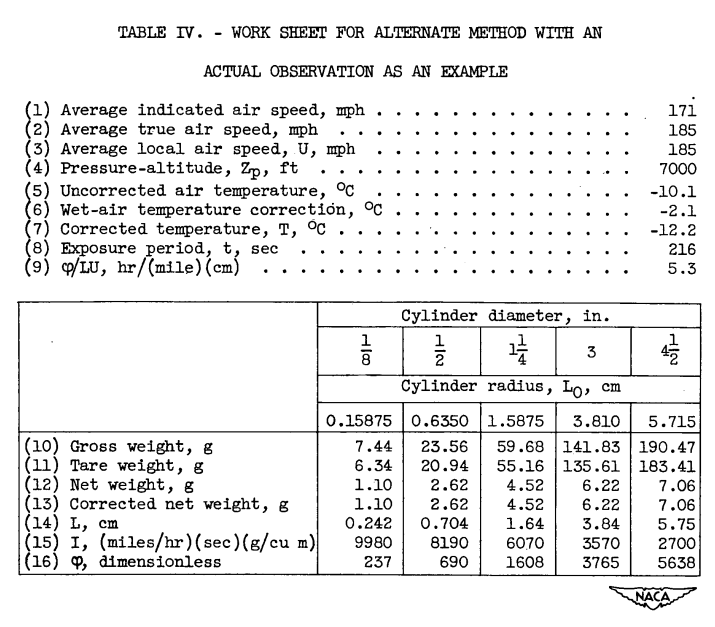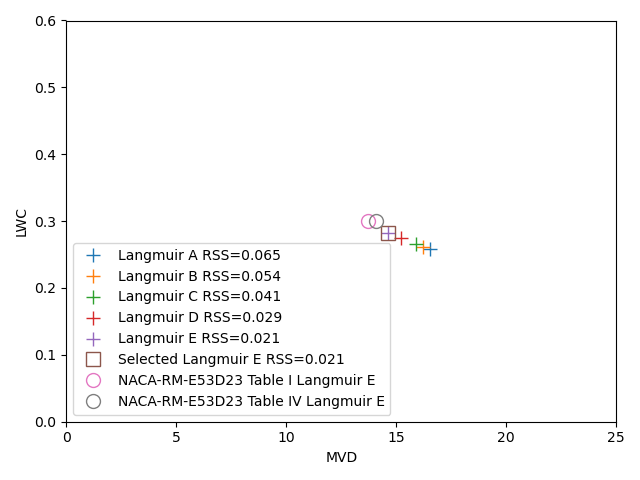"The meteorological data obtained with the multicylinder method are the only data available for the design of ice-protection equipment for aircraft"
"Procedure for Measuring Liquid-Water Content and Droplet Sizes in Super-cooled Clouds by Rotating Multicylinder Method"1

Summary
Detailed procedures for the use of multicylinders are described.
Key points
- Detailed procedures for the in-flight use of multicylinders are described.
- Detailed procedures for analyzing results from of multicylinders are described, with a flight data case.
- Differences in analysis method details can drive MVD and LWC differences in the range of 5% to 10%.
Abstract
The rotating multicylinder method for in-flight determination of liquid-water content, droplet size, and droplet-size distribution in icing clouds is described. The theory of operation, the apparatus required, the technique of obtaining data in flight, and detailed methods of calculating the results, including necessary charts and tables, are presented.
Discussion
Procedures
A set of rotating cylinders were constructed for use in flight. A picture of the cylinders deployed on an aircraft is shown above.
For this study, the assembly had five cylinders, as shown below.

The steps for in-flight measurements are detailed:
The basic steps involved in the application of the multicylinder method are essentially as follows:
(1) Exposure of a set of cylinders of different sizes in the super-cooled cloud for a measured time at a known pressure-altitude, true air speed, and ambient temperature
(2) Disassembly of the cylinders and storage of the ice-covered cylinders in separate water-proof containers
(3) Weighing of the individual cylinders plus containers in both the wet and dry condition to obtain the net weight of collected ice
(4) Determination of liquid-water content, droplet size, and droplet-size distribution by comparing the measured weight of ice collected on eacn cylinder with theoretical computations for comparable cylinders and comparable flight and atmospheric conditionsThese basic steps are discussed in detail in subsequent sections.
Analysis
The impingement tables from the recently published NACA-TN-2904 2 were used in the analysis of the measured cylinder data.
The data in Tables I and IV provide an actual measured flight data case. This case is different from other examples that we have seen, as the final outer diameter of the iced cylinder was not measured, but was calculated from an assumed ice density (850 kg/m^3).
The same cylinder data were processed in two different ways, yielding slightly different results (Tables I and IV).

Table I final result: MVD=13.7 micrometer, LWC=0.30 g/m^3, Langmuir E distribution.


Table IV final result: MVD=14.1 micrometer, LWC=0.30 g/m^3, Langmuir E distribution.
For the implementation of the NACA-TN-2904 impingement data, the analysis yields slightly different best fit results (file naca_rm_e53d23.py in 3) (The "RSS" value noted is a measure of the error of the fit).

In the review of NACA-TN-2904 impingement results were compared to Langmuir and Blodgett 4. It was also noted that Langmuir and Blodgett had an approximation, which can be corrected. A comparison of results with the different methods is shown below.
| Method | MVD | LWC | Distribution |
|---|---|---|---|
| Table I | 13.7 | 0.30 | Langmuir E |
| Table IV | 14.1 | 0.30 | Langmuir E |
| NACA-TN-2904 implementation | 14.6 | 0.28 | Langmuir E |
| Langmuir implementation | 15.2 | 0.30 | Langmuir D |
| Langmuir corrected | 15.2 | 0.30 | Langmuir E |
Differences in analysis method details can drive MVD and LWC differences in the of 5% to 10%. This is smaller than the differences drive by possible +/-5% mass errors analyzed in NACA-TN-2904 (inducing an MVD error of 10% and greater).
Conclusions
The limitations of the multicylinder method were summarized in the Conculsions:
The rotating multicylinder method for determining cloud-droplet size and liquid-water content has several inherent disadvantages; however, it is considered to be the most reliable technique known at this time that is adaptable to flight use. The meteorological data obtained with the multicylinder method are the only data available for the design of ice-protection equipment for aircraft. An important disadvantage of the method lies in its insensitivity in discriminating among different droplet-size distributions. An evaluation of the sensitivity is presented in reference 3. Another disadvantage is that the droplet-size distribution obtained by the multicylinder method is not necessarily the actual droplet-size distribution existing in the cloud but rather an assumed droplet-size distribution (table III). Although the actual droplet-size distribution in the cloud may affect the amount of ice collected on the cylinders in the manner described by the theoretical computations for an assumed droplet-size distribution, the area of coverage on an airfoil, or on other nonrotating members, in the cloud may differ from the area theoretically computed on the basis of the assumed distribution indicated by the rotating multicylinder method. The reason for the difference in area, or extent of coverage, is that the size of the largest droplets in the assumed distribution (given as a ratio to the volume median) is an arbitrarily assumed-value, and the multicylinder method does not provide a means for obtaining this value from the cloud data.
In obtaining the flight data, the airplane speed should be maintained as low as possible, because the final results are most accurate with low speeds. A discussion of the possible errors as a function of airplane speed and other variables is presented in reference 3. The limitations of the ice accretion rate caused by kinetic heating and heat of fusion are less severe at low air speeds (ref. 6).
A discussion of different forms of the multicylinder instruments and the effects of yaw, ice density, and other factors on the reliability of data and the reproducibility of measurements for conditions on a mountain is contained in reference 4.
"(ref.6)" is Fraser 5, and the "the limitations of the ice accretion rate caused by kinetic heating and heat of fusion" will be discussed in an upcoming review of NACA-TR-1215.
Citations
NACA-RM-E52D23 cites 6 publications:
- Langmuir, Irving, and Blodgett, Katherine B.: A Mathematical Investigation of Water Droplet Trajectories. Tech. Rep. No. 5418, Air Materiel Command, AAF, Feb. 19, 1946. (Contract No. W-33-038-ac-9151 with General Electric Co.) books.google.com
- Clark, Victor F.: The Multicylinder Method. Mt. Wash. Observatory Monthly Res. Bull., vol. II, no. 6, June 1946.
- Brun, Rinaldo J., and Mergler, Harry W.: Impingement of Water Droplets on a Cylinder in an Incompressible Flow Field and Evaluation of Rotating Multicylinder Method for Measurement of Droplet-Size Distribution, Volume-Median Droplet Size, and Liquid-Water Content in Clouds. NACA-TN-2904, 1953. ntrs.nasa.gov
- Howell, Wallace E.: Comparison of Three Multicylinder Icing Meters and Critique of Multicylinder Method. NACA-TN-2708, 1952. ntrs.nasa.gov
- Fraser, D., Rush, C. K., and Baxter, D. C.: Thermodynamic Limitations of Ice Accretion Instruments. Nat. Aero. Establishment, Ottawa (Canada), LR-32, Aug. 22, 1952. journals.ametsoc.org
NACA-RM-E53D23 is cited 5 times in the NACA Icing Publications Database 6:
- Dorsch, Robert G., and Brun, Rinaldo J.: Variation of Local Liquid-Water Concentration about an Ellipsoid of Fineness Ratio 5 Moving in a Droplet Field. NACA-TN-3153, 1954. ntrs.nasa.gov
- Gelder, Thomas F., Smyers, William H., Jr., and von Glahn, Uwe H.: Experimental Droplet Impingement on Several Two-Dimensional Airfoils with Thickness Ratios of 6 to 16 Percent. NACA-TN-3839, 1956. ntrs.nasa.gov
- Hacker, Paul T., Saper, Paul G., and Kadow, Charles F.: Impingement of Droplets in 60° Elbows with Potential Flow. NACA-TN-3770, 1956. ntrs.nasa.gov
- Brun, Rinaldo J., and Vogt, Dorothea E.: Impingement of Cloud Droplets on 36_5-Percent-Thick Joukowski Airfoil at Zero Angle of Attack and Discussion of Use as Cloud Measuring Instrument in Dye-Tracer Technique. NACA-TN-4035, 1957. ntrs.nasa.gov
- Gelder, Thomas F.: Droplet Impingement and Ingestion by Supersonic Nose Inlet in Subsonic Tunnel Conditions. NACA-TN-4268, 1958. ntrs.nasa.gov
An online search found that NACA-RM-E53D23 is cited 8 times in the literature 7.
Notes
-
Lewis, William, Perkins, Porter J., and Brun, Rinaldo J.: Procedure for Measuring Liquid-Water Content and Droplet Sizes in Super-cooled Clouds by Rotating Multicylinder Method. NACA-RM-E53D23, 1953. ntrs.nasa.gov ↩
-
Brun, Rinaldo J., and Mergler, Harry W.: Impingement of Water Droplets on a Cylinder in an Incompressible Flow Field and Evaluation of Rotating Multicylinder Method for Measurement of Droplet-Size Distribution, Volume-Median Droplet Size, and Liquid-Water Content in Clouds. NACA-TN-2904, 1953. ntrs.nasa.gov ↩
-
Langmuir, Irving, and Blodgett, Katherine B.: A Mathematical Investigation of Water Droplet Trajectories. Tech. Rep. No. 5418, Air Materiel Command, AAF, Feb. 19, 1946. (Contract No. W-33-038-ac-9151 with General Electric Co.) books.google.com ↩
-
Fraser, D., Rush, C. K., and Baxter, D. C.: Thermodynamic Limitations of Ice Accretion Instruments. Nat. Aero. Establishment, Ottawa (Canada), LR-32, Aug. 22, 1952. journals.ametsoc.org ↩